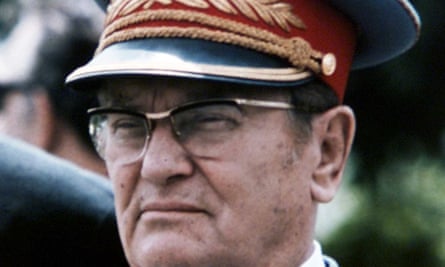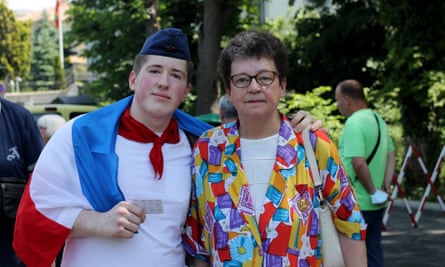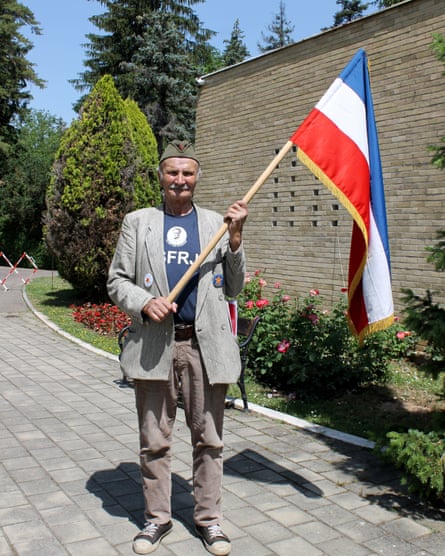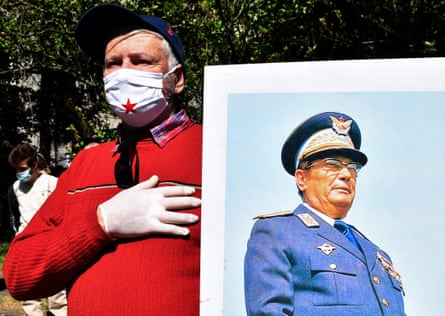On a recent day in Belgrade, as the sun beat down, coaches pulled up and departed outside the Museum of Yugoslavia, an imposing mid-century block in the Serbian capital. A steady trickle of people emerged, some carrying flowers and a few waving the country’s old flag. They had come to visit the mausoleum that houses the grave of Josip Broz Tito, the founder of socialist Yugoslavia.
Many of the visitors had grown up under the old system and had come to mark the dictator’s birthday, which was a major public holiday before Yugoslavia’s disintegration. Some belonged to far-left political parties, and sported kitsch-looking T-shirts and banners.
But there were also a few younger people. On the steps outside a special exhibition examining the Tito years via posters, artworks, artefacts and the recorded memories of “common people”, I met 18-year-old Milos Tomcic wearing the hat and scarf of the “pioneers”, the Yugoslav socialist youth movement.
“I wanted to see a picture of that time,” he said, when I asked why he had come. “It was a great time. Everyone loved each other.” Did he consider himself Serbian or Yugoslavian? “Yugoslavian,” he replied, without hesitation. “My mum is Serbian, my dad Montenegrin, my grandma Croatian. Actually, my family is from all over Yugoslavia.”
The Socialist Federal Republic of Yugoslavia, made up of six republics – Serbia, Croatia, Bosnia & Herzegovina, Slovenia, Montenegro and Macedonia – plus two autonomous regions – Kosovo and Vojvodina – was established by Tito in 1945.
Tito’s state aimed to unite the region’s different ethnic and religious groups under the slogan “unity and brotherhood”. Rising nationalism after his death in 1980 led to its breakup in 1992 and the bloody Yugoslav wars of the 1990s.
A common narrative during these years was that Tito had, for nearly half a century, forced different peoples to live together against their wishes. But 30 years on, many still hold deep affection for the country that no longer exists and regret its dissolution.

In Serbia, 81% say they believe the breakup was bad for their country. In Bosnia, which was always the most multicultural of the republics, 77% share that sentiment. Even in Slovenia, which was the first ex-Yugoslav country to join the EU and is widely regarded as the most “successful”, 45% still say the breakup was damaging. Unsurprisingly, only 10% in Kosovo, which didn’t have full independence in Yugoslavia, regret the breakup.
Fondness for the old system is often referred to as “Yugonostalgia”. However, Larisa Kurtović, a political anthropologist from Sarajevo who studies post-Yugoslav identity in Bosnia, is cautious about the term. “Nostalgia implies some kind of melancholy or longing,” she says. Of course this exists, with many restaurants and guesthouses around the region, such as the famous Café Tito in Sarajevo, festooned in kitschy memorabilia and presenting a rose-tinted view of the era. But Kurtović says there is also a movement of younger people who look more critically at the period, assessing both its positives and negatives.
“There’s a great deal of appreciation for the socialist period, and it’s associated with economic growth and vast improvements in the standards of living,” she says, adding that the Yugoslav project’s “failed promises” paled in comparison to the nationalism and violence that followed. Most ex-Yugoslav states have seen huge economic decline since the wars and still suffer high levels of brain drain.
Bosnia and Serbia in particular are plagued by political strife, and their once utopian brutalist housing estates and Yugoslav-built railways sit decaying. Although Croatia and Slovenia have found relative stability as EU members, other countries’ applications have stalled and negotiations failed to materialise, leaving many doubting whether they will ever join the bloc.
Against this backdrop, some wonder whether the past could hold any solutions for the future. Kurtović cites the workers’ rights movements that have sprung up in Bosnia over the last decade, based on the old Yugoslav socialist model of worker self-organisation. “This system was very specific to Yugoslavia,” she says, explaining its divergence from Stalinist state-ownership of industry.
Although Yugoslavia was a one-party state, there were distinct differences from other iron curtain countries. Tito founded the non-aligned movement and maintained balanced relationships between the west and the USSR, and Yugoslav citizens could travel to either region. The strength of the old Yugoslav passport is mentioned by many of those I meet visiting Tito’s grave who now require visas to enter most countries.


Another common theme Kurtović sees is a loss of status, and a perception that people have gone from living in a relatively large, well-respected country to much smaller, less significant ones. George Peraloc was born in Macedonia (now North Macedonia) in 1989 but currently lives in Bangkok. “Whenever I have to do something bureaucratic like open a bank account here, they can never find North Macedonia on their system, but they can find Yugoslavia,” he told me.
“If you ask me, we could still benefit from a federation, even if it’s not Yugoslavia, because we’re so small and insignificant on our own.” He believes these feelings are common among people of his age, who never actually lived under the old system. “All our infrastructure is from that period, and now it’s falling apart,” he adds.
There are also emerging movements that re-examine the region’s anti-fascist, anti-nationalist heritage, which the wars revised or sought to erase. Choirs singing old partisan songs have sprung up, both in the Balkans and among diaspora communities.
In Vienna, the 29 November choir, named after the date the Federal People’s Republic of Yugoslavia was declared in 1945, consists of members from all ex-Yugoslav countries. Its initial aim was to challenge the nationalism that rose in the diaspora community during and after the wars. Yugoslav workers’ clubs, where people had formerly met to drink coffee, chat and play chess, had become segregated by ethnicity.
Choir members dress in red and blue jackets with stars, referencing the old Yugoslav flag, but they avoid singing songs associated with the Communist party or that celebrate Tito.
“That’s a conscious decision because we know there’s a glorification happening, which is problematic,” says conductor Jana Dolecki, who is originally from Croatia and moved to Vienna in 2013. “Plus, they didn’t really have any good songs,” she laughs.
after newsletter promotion
Instead, members carefully select melodies they believe can be applied to current political struggles such as rising nationalism and populism. “We try stay away from historical revisionism,” she says. “You can get into this celebration of the past, always saying it was better, but not reflecting on what ‘better’ actually means.”
The choir has helped some members explore a sensitive period of history. Marko Marković, who was born in Belgrade but grew up in Vienna, says his family refused to discuss the wars with him as a child. “It was too complicated for a seven-year-old to understand, or so they thought,” he remembers. “So I always had the feeling that the history of where I came from is a taboo topic.” When he found the choir, he felt he could finally “patch up some holes.”
The internet also provides a gateway for people to rediscover overlooked aspects of their heritage. Several popular Instagram accounts collate the furniture, brutalist architecture and graphic design of the period.

Peter Korchnak, who grew up in then Czechoslovakia, launched the Remembering Yugoslavia podcast in 2020. “Growing up, Yugoslavia seemed like a paradise to me,” he says, explaining that many people fleeing the Czechoslovakian regime would escape to Yugoslavia. Dissidents from other communist countries, such as Ceaușescu-era Romania, often did the same.
“We watched the violent dissolution of Yugoslavia while I witnessed my own country’s peaceful dissolution,” he says. “I started looking for comparisons, comparing the two. And I just became fascinated by it.”
Korchnak has been struck by the emotional outpouring he receives from some listeners. “The best comment I’ve heard is that it’s like a public service,” he says. “And a lot of people say, ‘For a long time I was ashamed to even think the word ‘Yugoslavia’. Some have said it’s even been like therapy.”


Korchnak finds the fondness many ex-Yugoslavs have for their old system striking. “You might hear older people [in Slovakia] saying, ‘Oh, things were cheaper back then,’ but mostly everyone has moved on,” he says. “But [in ex-Yugoslavia] it’s kind of transformed into something else.”
However, some are more critical of what they see as an over-romanticism of the period. Arnela Išerić’s family are from Bosnia and fled to the US, where she was raised during the war. “My impression as a child was that [Yugoslavia] was the most wonderful time and everything was harmonious,” she says. “But when I grew up, I realised there were things about it I did not like.” She cites the lack of LGBT rights and suppression of political dissent. However, she says she can still identify with the “spirit” of Yugoslavia.
“When I travel to other parts of the region, such as Montenegro or Croatia, I always feel like I connect with people. I can speak their language and we have a similar culture.”
As time moves on and younger people are less directly affected by the trauma of war, some feel it’s becoming easier to analyse the period. “Almost every day, someone is asking if they can interview us for their dissertation on post-Yugoslav identity,” says Dolecki, the choir conductor. “For a long time it was a socially taboo topic,” agrees her colleague Marković. “But this generation has the luxury of being far enough away to not have all the biases, and the trauma that comes with it. And I think this will become bigger.”
